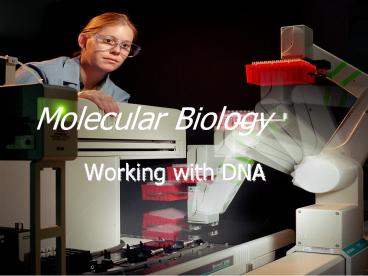Molecular Biology - PowerPoint PPT Presentation
1 / 40
Title:
Molecular Biology
Description:
Title: La G nomique Author: jbasso Last modified by: mcadieux Created Date: 7/14/2003 6:30:35 PM Document presentation format: On-screen Show (4:3) – PowerPoint PPT presentation
Number of Views:16
Avg rating:3.0/5.0
Title: Molecular Biology
1
Molecular Biology
- Working with DNA
2
Topics
- Genomic vs. Vector DNA
- Purifying plasmid DNA
- Restriction enzymes
- Restriction maps
3
DNA
- Genomic
- Prokaryote vs. eukaryote
- Circular or linear
- One or more chromosomes
- Extra-genomic
- Vectors
- Plasmids
4
Vectors Vs Plasmids
- Vector
- DNA vehicle that allows the cloning, maintenance
and amplification of a DNA sequence - Plasmids
- Virus
- Chromosomes
- All plasmids are vectors
- Not all vectors are plasmids
5
Plasmids
- Small circular DNA molecules maintained and
amplified in eukaryotic or prokaryotic cells - Amplification in bacteria
- Used as vector for cloning or expression of DNA
of interest
6
Characteristics of plasmid vectors
- Restriction sites for cloning
- Origin of replication (Ori)
- Selection marker
- Genes conferring resistance to antibiotics
7
DNA Isolation
- Goals
- Isolation of DNA of interest
- Chromosomal or plasmid?
- Eliminate other components
- Chromosomal or plasmid DNA?
- Proteins
- RNA
- Chemicals
- Salts, detergents, etc.
8
DNA isolation (contd)
- Cell lysis
- Cell wall and membrane
- Enzymatic
- Chemical
- Mechanical
- Isolation of DNA of interest
- Differential sedimentation
- Chromatography
- Removing other components
- Enzymatic
- Differential sedimentation
- Chromatography
9
Plasmid DNA isolation by alkaline lysis (E.coli )
10
Solutions Used
- Sol. I Resuspension buffer
- Tris HCl Buffer that protects nucleic acids
- EDTA - Chelates Mg, prevents nucleases from
working - Sol. II Lysis solution
- NaOH - pH lyses cells, denatures DNA
- SDS Dissolves membranes, denatures and binds
proteins
11
Solutions Used (Contd)
- Sol. III- Potassium acetate
- Renaturation of DNA
- Precipitates SDS
- Precipitates genomic DNA and proteins
- Isopropanol / Ethanol
- Precipitates nucleic acids (plasmid and ?)
- Salts remain soluble
- TE-RNase - Tris EDTA again RNase??
12
Quantification of DNA
- Determining Conc. of DNA
- A260 of 1.0 50µg/mL or 50ng/µL
- Determining Amount of DNA
- 1mL of a solution with an A260 of 1.0 contains
50µg DNA - 1µL of a solution with an A260 of 1.0 contains
50ng DNA
- Do not forget to account for the DILUTION FACTOR
13
Restriction enzymes
- Endonuclease
- Cleaves internal phosphodiester linkages.
- Recognize specific double stranded DNA sequences
- Different endonucleases recognize different
sequences - Recognize palindrome sequences
14
Palindromes
- The same sequence is read in the 5 3
direction on both strands
5-G
G
A
T
C
C-3
3-C
C
T
A
G
G-5
15
- The same phosphodiester linkages are cleaved on
both strands!
16
Different ends are generated
Blunt ends
17
Different ends are generated
5 overhangs
18
Different ends are generated
3 overhangs
19
Compatibility of ends
Compatible
20
Compatibility of ends
21
Compatibility of ends
Annealing
Compatible
22
Compatibility of ends
Annealing
Incompatible
23
Restriction Maps
24
Restriction maps
- Determining the positions of restriction enzyme
sites - Linear DNA maps
- Circular DNA maps (plasmids)
- Maps of inserts within vectors
25
Approach
- Determine whether the DNA has digested
- Is the digestion complete or partial?
- How many cuts?
- Determine the relative positions
26
Is the DNA digested?
Ladder
Control
- Compare to the undigested control
- Which samples were not digested?
- 1 and 4
- Which samples were digested?
- 2 and 3
1
2
3
4
27
Is the digestion complete?
- Complete digestion
- All the DNA molecules are cleaved at all the
possible sites - Partial digestion
- A fraction of the molecules are not digested
- Partial undigested
- A fraction of the molecules were digested, but
not at all the possible sites - Partial digestion
28
Complete digestion
Digestion
29
Partial digestion Partial undigested
Digestion
30
Partial digestion
Digestion
31
Is the digestion complete or partial?
- Compare to control
- Verify the intensity of the bands
- Verify the sizes
32
How many cuts?
- Number of sites
- Circular DNA number of bands
- Linear DNA Number of bands 1
33
Linear DNA maps
Enzyme Fragments (Kb)
HindIII 3 and 4
SalI 2 and 5
HindIII SalI 2 and 3
34
Circular DNA maps (plasmids)
Enzyme Fragments (Kb)
BamHI 2, 3 and 5
HindIII 1 and 9
BamHI HindIII 1, 1.5, 2, 2.5 and 3
35
Insertion maps
MCS
36
Approach
- Determine the total size
- Determine size of the insert
- Total size size of vector
- Determine the insertion site within the MCS
- Determine which enzymes cut wihin the insert
- Relative mapping in relation to the sites at
known positions
37
Insertion maps
- Total size
- 7.7Kb
- Insert size
- 7.7 2.7 5.0Kb
- Insertion site
- Generates 2 fragments of which one is the size of
the vector - XbaI
Enzyme Fragments
BamHI 7.7Kb
EcoRI 1.0, 3.0, 3.7Kb
PstI 2.0 and 5.7
XbaI 2.7 and 5.0
38
Insertion maps
Enzyme Fragments Total cuts Sites in vector Sites in insert
BamHI 7.7Kb 1 1 0
EcoRI 1.0, 3.0, 3.7Kb 3 1 2
PstI 2.0 and 5.7 2 1 1
XbaI 2.7 and 5.0 2 Insertion site 0
39
Map of PstI 2 and 5.7Kb
5.0
40
Map of EcoRI 1, 3 and 3.7Kb































